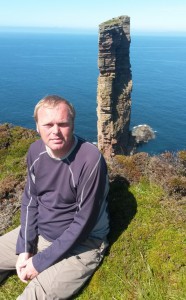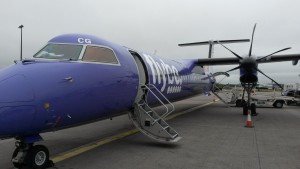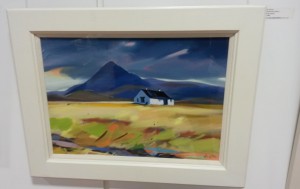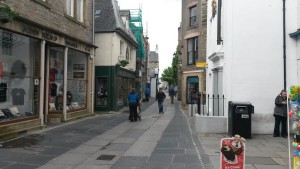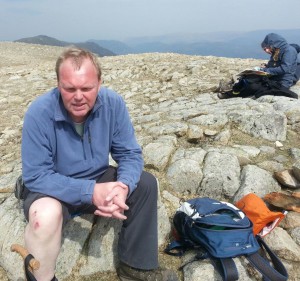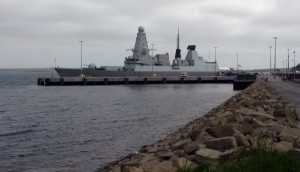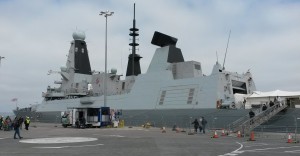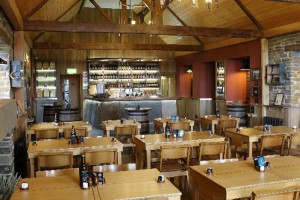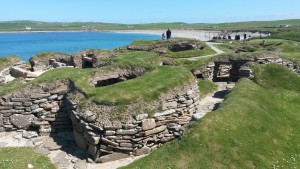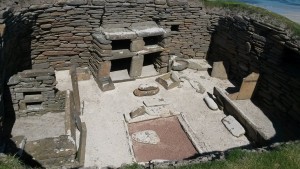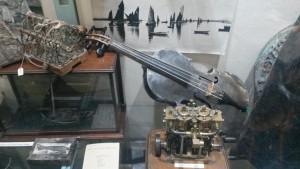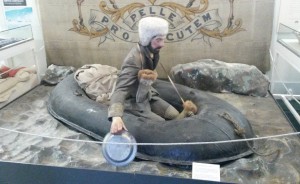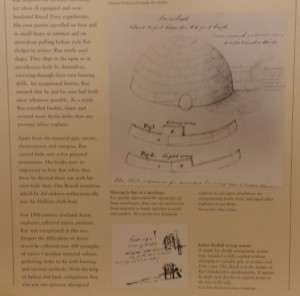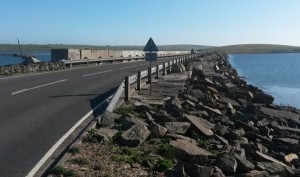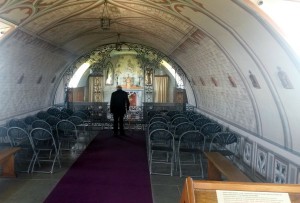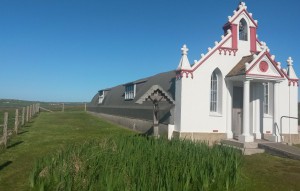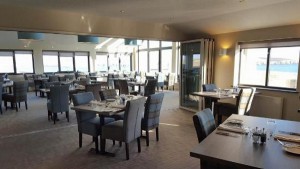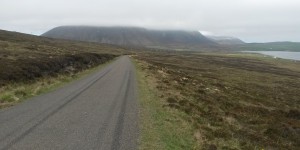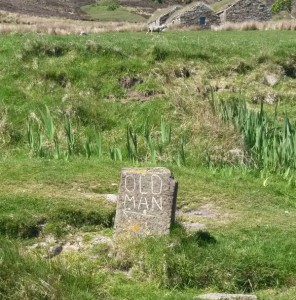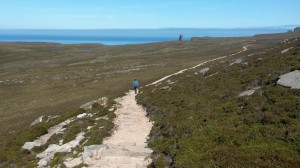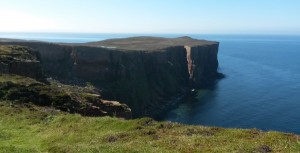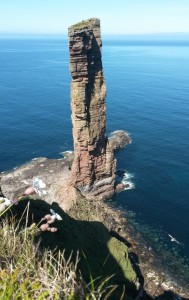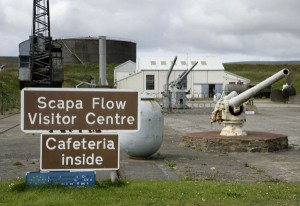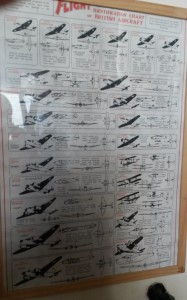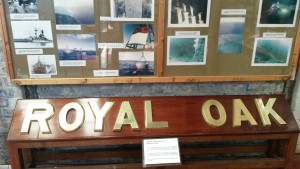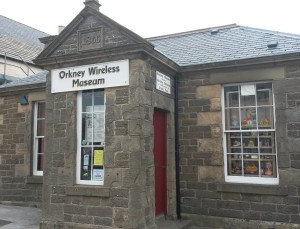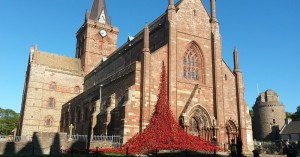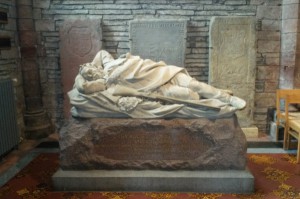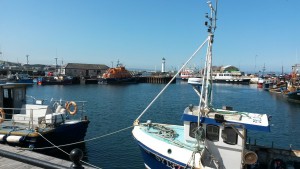Apologies for not updating the site for a little while.
Between the Black Forest trip and Orkney, I’ve been home for 3 days in the last 3 weeks.
I’ve decided to write this weeks entry about Orkney. Why ?. Its a dull lonely Island in the middle of nowhere, like something out of Father Ted isn’t it ?
Well that’s what I thought it would be like, but it was completely inspiring and I got to do 2 fantastic things from my 2nd bluelist while there..
Nikki’s parents wedding anniversary. They could go anywhere they wanted, chose Orkney and the whole family went along.
I was invited as well 🙂
It actually took 2 planes to fly to Orkney.
The first plane was quite small, had propellers and flew to Aberdeen.
In Aberdeen airport, we had some breakfast and they had some art work for sale.
I saw this picture and instantly recognised where it was.
The Camasunary bothy on the Isle of Sky, with Bla Bheinn in the background.
It put me in a good mood, which was important, as our 2nd plane was like a reliant robin with wings.
Once onboard, they didn’t serve any alcohol on the flight and our right hand engine was struck by lightening :(.
I did my “dentist thing”, closed my eyes tight and imagined I was somewhere else, doing something completely different 🙂
But we arrive in one piece and are transported to our hotel.
Orkney is an Archipelago (which for those that dont know, means it isn’t just an Island, but a sort of “consortium” of small islands together).
Made up of 70 Islands of which 20 are inhabited, the area was given to Scotland as a wedding dowry.
We spent most of our time on the main Island called Orkney, and our hotel was located in the capital Kirkwall.
In fact we stayed in the Kirkwall hotel. A cracking spot with great views of the harbour.
It looked a bit rundown, but the service was top notch, our room had a bath, a friendly bar and served very good food.
The whole area was buzzing with people, there to celebrate the centenary of the battle of Jutland (more about that when I visit the Scapa Flow visitor centre).
The occupants of the Islands do not like to be called Scottish and describe themselves as Orcadian.
One thing I should mention at this point.
While away on a walking weekend to celebrate my birthday, I took a fall.
I hit my my knee, then bounced over and landed on my side. I only realised later, that my camera was in a pouch on my belt and when I landed on it, I bent the frame and destroyed it.
So for the first time, every photo your going to see on this section of johnsunter.com was taken with a mobile phone (my Samsung Galaxy S4 Mini).
Our first morning, and we make plans for the day.
Orkney has several “interesting” Neolithic sites and we set out out to see them.
On the way I saw a unique looking military ship in the harbour and I was fixated. There’s only 1 type of ship in the British navy that’s designed that way !.
Brilliantly, as The Battle of Jutland was being celebrated, there was a Daring Class Destroyer moored in the harbour that you could go and see.
HMS Duncan is the newest of the 6 The Daring Class Type 45 destroyer’s
I’d read loads of stuff about them and I was fascinated to finally see one.
It’s the most advanced ship of its kind in the world. In simulation tests, it can outperform 4 type 42 destroyers (which it supersedes) combined.
It’s radar guided weapons systems can track 1000 fast moving targets the size of cricket balls, all at the same time.
I’d only been on Orkney a few hours and already felt like I’d achieved something pretty amazing.
We continued on to visit 2 fascinating Neolithic sites.
This is johnsunter.com so instead I’ve put up a picture of the Orkney Brewery where we had lunch.
I’ve included links to The Standing Stones of Stenness and The Ring of Brodgar for those interested.
The RSPB gave an interesting talk on local birds.
I was more interested by local livestock. There are 20,000 people on Orkney and 100,000 cows.
I’ve always enjoyed Aberdeen Angus Burgers from Tesco.
While we passed a field, I got to see some for the first time. They can be instantly recognised, as they are black.
We continue on, and visit one of the oldest village sites in the world (older than the Pyramids, Stone Henge and the Great Wall of China) Ness of Brodgar.
It had a little visitors centre with some multimedia presentation and souvenirs.
From here you can wander outside and see the actual structures and buildings. With my bushcraft experience I could see how the buildings had been organised and constructed to compliment each other.
It was also a beautiful day and one of the staff commented it was the nicest day of the year.
This is one of the buildings with its roof removed.
You can see the fire hearth in the centre, and stone bed emplacements around it (foliage would be added for comfort, fire would provide warmth and the sod roof would protect the occupants from wind and rain.
Interestingly at the front is a sort of sideboard for storing tools and ornaments. All of the buildings had this same “cupboard design” and its been adopted as the symbol of Ness of Brodgar.
The village had ultimately been abandoned, and nobody knows why.
Included with the admission was a visit to the nearby the Skaill house.
A stately home with loads of old artefacts like military clothing from the Peninsula war, old portraits and a book case with a secret compartment.
After lunch, we drive to the other end of the Island and a place called Stromness to visit a museum there.
Like many of the museums we saw it was very quirky and with a disparate collection of artefacts.
I found them all interesting, but in honesty I felt like instead of starting with a theme and setting up a collection, they just got hold of anything they could and put it out on show.
Above for example a chap on board ship had his fiddle destroyed (he’s said to have entertained the crew with it, but perhaps someone didn’t like his music 🙂
While at sea, he had no conventional means to repair it, so made this replacement from tin.
In another section were 2 stuffed Otters which someone had run over by accident and donated !.
I was fascinated by all the stuff on Dr John Rae, a local born physician turned explorer.
he made extensive use of early inflatable boats (pictured above using a plate as a paddle).
He spent much time in Hudson bay and learned to live off the land from the natives.
His extensive books and papers catalogued various skills and resources, and here notes on constructing an Igloo.
From here we travelled to a small Island called Lambholm.
Many of the Island were connected by a causeway called the Churchill barrier.
They were constructed to limit submarines ability to enter an area called Scapa Flow, a large expanse of water in the middle of the Orkney Islands after The Royal Oak was was sunk at her moorings there.
The Churchill barriers were built by some prisoners of war (they were able to get around the Geneva convention, saying they were to assist with inter Island communication).
One set of prisoners tried to make their time as comfortable as they could. Italian, they began by constructing tables and chairs so they could enjoy meals outdoors in the Summer.
Later they asked for some utility buildings. Deeply religious, they used artisan skills to convert it into a Chapel.
Above you an see what it looks like inside, even to this day.
When shown from this angle, you can see that its basically a store room but remarkably made up like a chapel.
One thing that surprised me, was how the Italians were so comfortable there and wanted to settle in.
As the war came to an end, several of them asked to stay to complete the Chapel before they were “forced” to go home 🙂
Back to our hotel and get ready in my best Rohan Clothes.
It’s the actual evening of the 50th wedding anniversary, and everyone is really excited.
We had out to an incredible restaurant called Foveran.
Amazing food, wine and attentive (and well informed) staff with spectacular views across Scapa Flow.
Next morning, up early and onto the ferry.
We’ve decided to visit another Island called Hoy, where I’m going to pursue a project I’ve had on my mind for close to 30 years.
When we arrive, the Island is pretty much like the one in Father Ted !.
We drive around, and are able to locate our position on the map using picnick area’s as in many cases there is literally nothing there. But, the excitement is building up.
We find the spot were looking for and park up (there’s a small campsite and hostel and you can park your camper van for 7 days for free !).
The weather has improved now, and I see the first sign of the thing I’ve come to see.
We set off up hill.
Its steep at first but then flattens out onto a clear path across the hills that soon become cliff tops.
From here, the views of the cliffs and the ocean are spectacular.
I’m reminded (if it was ever needed) why I love hill walking so much.
And then, there it is.
The Old Man of Hoy, the iconic sea stack in Rackwick Bay.
449 feet high and 180 feet from the mainland (where this shot was taken).
First climbed by Chris Bonington in 1967.
I saw it on tv one Sunday afternoon when I was 13 (The famous Joe Brown and his daughter Zoe were climbing it together).
There is even a Tupperware container on the top, with a book inside for people to sign when they’ve climbed it.
We walk back in a contemplative mood (I’m especial glad I saw it, as experts say it probably wont be there in 15 years).
Places to get lunch are thin on the ground in this far flung place.
We were heading to the SFVC anyway, so we headed for their excellent 40’s themed cafe which I’d highly recommend.
They had lots of large weapons and vehicles and hundreds of fascinating articles and historical photographs.
As well as the main building, they had this massive oil container which had been emptied out and is used as part of the museum.
Inside it was lit up and like something from the X Files.
Loads of different vehicles and displays and a 30 minute video that explained the full the history of Scapa Flow and its significance in the first and 2nd world wars.
There was also an old air raid shelter that we walked around.
The battle of Scapa Flow happened in the First world war and remains the largest warship battle in history.
The circumstances beggared belief.
A ship might sink and 600 people on board would drown with only 3 survivors !.
At the end of the battle. The British had lost 6000 men and the German Navy 2000. However neither side could claim victory and the German navy stayed out of the area for the duration of the war.
At the conclusion of the war, and as a condition of teh armistice agreement the German Hochseeflotte (high sea fleet) was escorted to Scapa Flow to be interned.
The bulk of the crew were sent home and the ships remained in “parked”in Scapa Flow.
Details are unclear, but at some point, Admiral Ludwig von Reuter got hold of a copy of the Times. Realising his government had resigned and concerned that the ships would be made available to the British, he ordered the fleet scuttled.
With their Sea cocks open, 52 ships were sunk within a matter of hours.
years later, the ships were raised and the metal harvested for various projects.
During the 2nd world war, the Royal Oak sunk was sunk at its moorings by German submarine the U-47.
This damaged moral and resulted in the Churchill barriers being constructed.
The wreck of the Royal Oak was designated a war grave, but a recreational diver took its name plate without permission.
It was returned 20 years later from Canada and here it sits in the Scapa flow visitors centre.
Ferry back to Orkney, Italian for dinner and an early night after such a rewarding day.
Our final day in Orkney and we explore around the area local to our hotel.
The Orkney wireless museum has more radio equipment in it in one place then I’ve ever seen in my life.
It was amazing to see the transition of radios over the decades through valves and transistors.
The proprietor explained that radio communication in the early days had been driven by the navy for obvious reasons.
Best of all, I got to try out a crystal set. I had a go at making one some years ago from instructions in a scout anual but never got it to work.
This one worked fine, and I was listening to Amy Winehouse on BBC Radio Orkney.
I had a brief look at Orkney museum, then headed across the road to visit St Magnus Cathedral.
A remembrance service had been held the previous Sunday and there had been lots of well behaved sailors staying in our hotel.
I’m not very religious and churches look much the same to me.
However, this one featured a memorial to the explorer Dr David Rae who I’d seen at Stromness museum.
It showed him resting for the evening on the ground with his blanket and rifle at the ready
And before I know it, its 2pm and time to head back to the airport and the flying coffin that will take me home.
I have one last look at the harbour I’ve grown to love and off I go.
